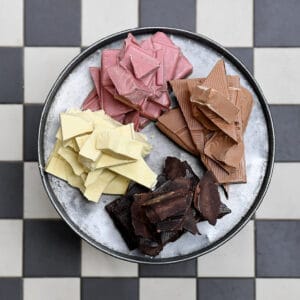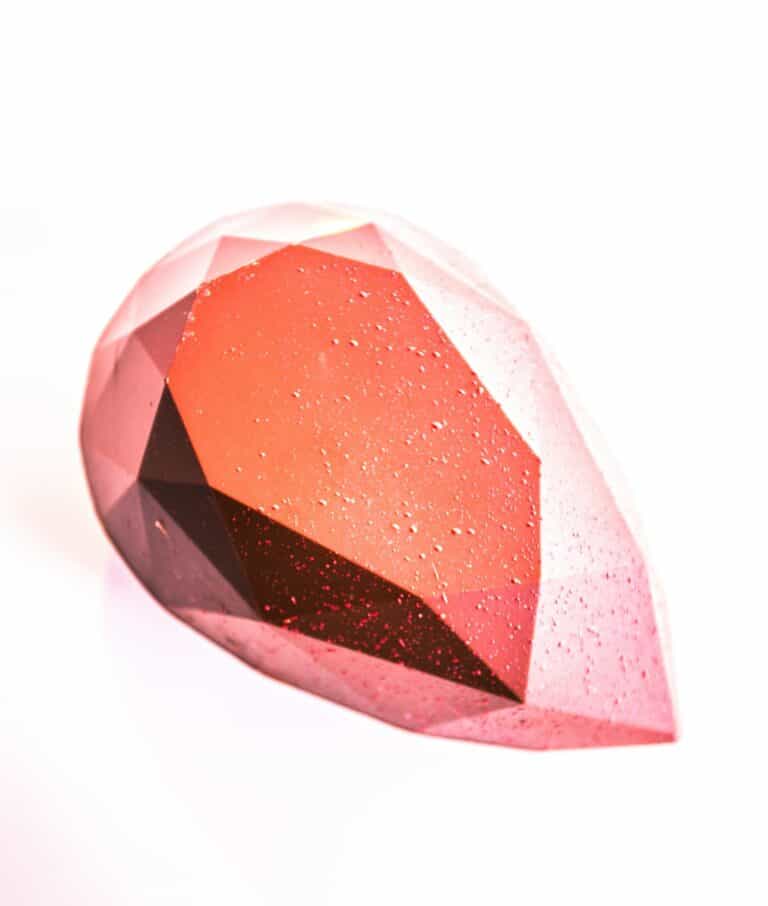As a chocolate enthusiast, I’ve come across various types of chocolates, but none are quite as intriguing as ruby chocolate. Being hailed as the fourth type of chocolate, ruby chocolate has made quite an impact in the chocolate industry, and it’s not just because of its uniquely beautiful pink hue. Made with ruby cocoa beans, this new chocolate offers a taste that’s unlike the three traditional chocolates: dark chocolate, milk chocolate, and white chocolate.
What sets ruby chocolate apart from the other types is the distinct fresh berry fruitiness and luscious smoothness that it brings to your taste buds. Some even describe the taste as a combination of berries, with hints of refreshing citrus fruits. Introduced by Barry Callebaut, a renowned Belgian-Swiss cocoa manufacturer, ruby chocolate bars are made from ruby cocoa beans, which are a unique variety of cocoa bean found primarily in the Ivory Coast, Ecuador, and Brazil.
The secret behind ruby chocolate’s remarkable pink color lies in the fermentation process of the cocoa beans. Unlike other chocolates, it doesn’t rely on colored fat or flavored cocoa butter to achieve its coloring. The beans’ natural elements, such as citric acid, induce the pink hue during the fermentation process, which gives the final ruby chocolate product its signature look and taste. Additionally, innovative ruby chocolate products like ruby chocolate chips and ruby cacao nibs have begun to appear on the market, expanding the ways for everyone to enjoy this unique flavor experience.

The Origins of Ruby Chocolate
As a devoted chocolate lover, I’m excited to dive into the origins of Ruby Chocolate, the newest addition to the chocolate family. Ruby chocolate joined the ranks in 2017 alongside its well-known counterparts: white chocolate, milk chocolate, and dark chocolate. Invented by the world-renowned Barry Callebaut, ruby chocolate has since captivated chocolate enthusiasts with its unique taste, bold color, and luscious smoothness.
Derived from Ruby cocoa beans, this chocolate variety is the product of cacao beans that have undergone a unique fermentation process. Not all cocoa beans can produce ruby chocolate, as only Ruby cacao beans from specific regions (such as Ecuador, Brazil, and the Ivory Coast) possess the potential to create this distinct treat. The innovative fermentation technique is what ultimately brings forth the chocolate’s pink hue, fresh berry fruitiness, and delightful lemon notes found within Ruby chocolate products.
Unlike other chocolates, this fascinating confection boasts a naturally pink color that sets it apart from traditional chocolate. Ruby chocolate is not tinted with food coloring or other artificial dyes, as the pigmentation comes exclusively from the Ruby cocoa beans themselves. The pink hue is the result of a sour organic substance found in the beans, making ruby chocolate a one-of-a-kind creation.
If you’re curious about how its flavor profile differs from its counterparts, you’ll be pleased to discover that this fourth type of chocolate captures an incredible mix of berry flavor and citrus fruits. The primary ingredients found in ruby chocolate include cocoa mass, cocoa butter, milk powder, and small amounts of citric acid for added zest. The result is a harmonious blend of tastes and textures that are sure to delight your taste buds.
When it comes to purchasing ruby chocolate, it’s currently only available through Barry Callebaut or select retailers. You can find ruby chocolate bars, chips, and other ruby chocolate products to satisfy your cravings or introduce a twist to your favorite recipes. As new chocolate experts experiment with this innovative type of chocolate, I anticipate an even greater range of ruby chocolate offerings to hit the market soon.
In conclusion, the introduction of ruby chocolate to the chocolate industry has revolutionized both the artistic and culinary realms. From its captivating ruby color and unique flavors to its all-natural origins, it’s evident that ruby chocolate is here to stay. For those with adventurous taste buds, I encourage you to explore this remarkable fourth chocolate and experience its tantalizing qualities for yourself.
Flavor Profile and Texture

Ruby chocolate, the fourth type of chocolate, has been captivating hearts and taste buds since its unveiling by Barry Callebaut in 2017. This pink chocolate offers a unique and different experience compared to milk chocolate, dark chocolate, and white chocolate. When it comes to the flavor profile and texture of ruby chocolate, there’s a lot to explore.
Made from unique ruby cocoa beans, ruby chocolate has a fresh berry fruitiness to it. Its taste is often described as a mix of berries, lemon notes, and hints of citrus fruits, with an underlying sweetness similar to milk chocolate. This distinct flavor profile is a result of the natural components present in the ruby cocoa bean itself. Also, its fermentation process plays a crucial role in enhancing ruby chocolate’s flavor. Cocoa beans from Ivory Coast, Brazil, and Ecuador contribute to the production of this pink-hued delicacy.
Texture-wise, ruby chocolate is known for its luscious smoothness. The primary ingredients used for making ruby chocolate are ruby cocoa nibs, sugar, cocoa butter, and milk powder. Unlike flavored cocoa butter, the pink color of ruby chocolate is derived from the ruby cocoa bean itself, with no added colors or flavors.
If you’re tempted to buy ruby chocolate, the market has a plethora of products and options. Popular choices include ruby chocolate bars, ruby chocolate chips, and even ruby couverture for baking purposes. The only catch is that only Barry Callebaut is currently selling ruby chocolate, making it somewhat exclusive.
Speaking of ruby chocolate products, the pure bars come in different shapes and sizes, with some featuring inclusions like nuts, fruits, and spices. When trying a ruby chocolate bar for the first time, it’s advisable to start with pure bars to enjoy the unique flavors and texture in their full glory.
While new to the chocolate world, ruby chocolate is undeniably gaining traction in the industry, with an ever-growing list of ruby chocolate products being introduced. As chocolate experts continue to experiment with this new, naturally pink type of chocolate, one can only wonder what delightful concoctions they’ll come up with.
As we’ve seen, ruby chocolate’s taste and texture stand out due to its unique characteristics, such as its fresh berry fruitiness and smooth, creamy mouthfeel. Those looking to satisfy their curiosity or simply delight their taste buds should definitely give ruby chocolate a try. After all, life is too short not to indulge in this fantastically unique and visually stunning chocolate experience.
Let’s wrap up what we’ve learned about ruby chocolate. It’s an exciting innovation in the world of chocolate, as it’s the fourth type of chocolate, joining the ranks of white, milk, and dark chocolate.
A few key points about ruby chocolate include:
– It’s made from unique ruby cocoa beans, which give it a distinct pink hue and fresh berry fruitiness.
– The ruby chocolate taste is described as having luscious smoothness and a fruity flavor, often compared to citrus fruits and berries.
– Barry Callebaut, a leading chocolate manufacturer, introduced ruby chocolate to the market, and it’s since made its way into various products.
– Ruby chocolate bars, chips, and other products are available for purchase, but the purest form is ruby couverture.
– The pink color of ruby chocolate comes from the cocoa bean itself and not from artificial coloring.
What sets ruby chocolate apart from other types of chocolates is its unique taste and naturally pink coloring. The fermentation process used in making ruby chocolate helps in achieving these unique flavors and color.
As a chocolate enthusiast, I find it fascinating how the chocolate industry continues to evolve, introducing new chocolate varieties to tempt and satisfy our taste buds. The ruby chocolate, with its berry fruitiness and citrus notes, offers a truly delightful alternative to traditional chocolate. Whether in the form of ruby chocolate bar or ruby chocolate chips, these products are definitely worth trying for any chocolate connoisseur.
Keep an eye out for ruby chocolate products on the market, as more chocolate experts and manufacturers start selling this luscious and flavorful treat. It’s a colorful addition to the chocolate world, and I’m eager to see how its presence grows in the coming years. So if you haven’t yet, it’s time to seek out some ruby chocolate and revel in the unique experience that it offers.
